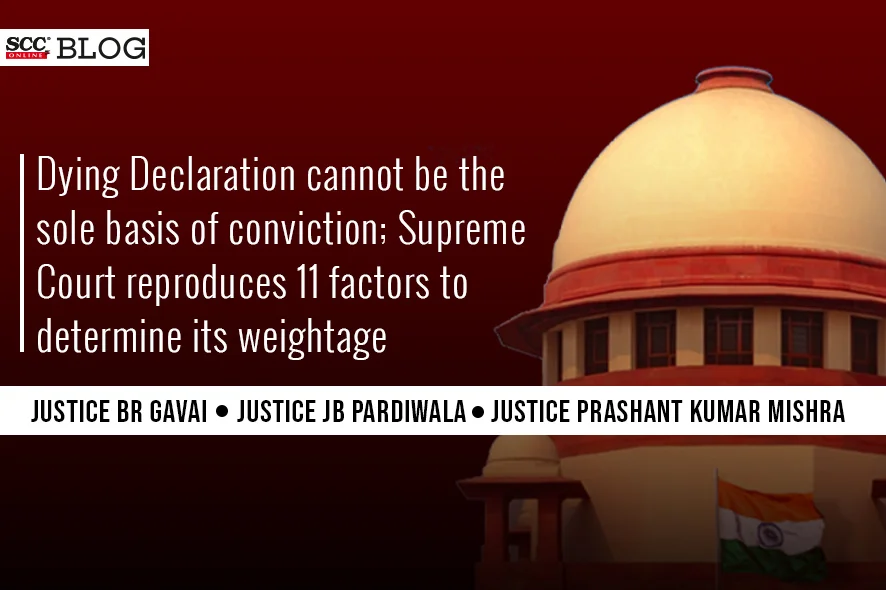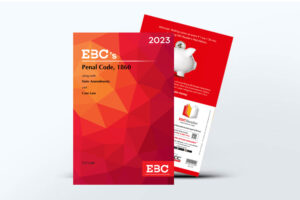Supreme Court: In appeal filed by the convict against the judgment and order passed by the Allahabad High Court, wherein the Court affirmed the conviction order and sentence of death passed by the Sessions judge for the offences punishable under Sections 302, 436 and 326-A of the Penal Code, 1860 (‘IPC'), the full bench of BR Gavai, JB Pardiwala* and Prashant Kumar Mishra, JJ. while setting aside the conviction order, has held that dying declaration while carrying a presumption of being true must be wholly reliable and inspire confidence. Where there is any suspicion over the veracity of the same or the evidence on record shows that the dying declaration is not true it will only be considered as a piece of evidence but cannot be the basis for conviction alone.
Background:
The convict was married twice. Out of first marriage a son (deceased) was born. The convict had two brothers (deceased persons), who lived along with him and his sister. It is the case of the prosecution that the three deceased persons were against the second marriage of the convict, thus, the convict set them on fire, when all three deceased persons were sleeping in one room. The witness/ sister had claimed to have seen the convict setting the room on fire and thereafter, fastening the door latch from outside and running away. The dying declaration of convict's son and one brother were recorded, wherein they have said that the convict has set them on fire.
The convict was awarded death penalty with fine of Rs. 20,000/- by the Trial Court for the offence punishable under Section 302 IPC. For the offence punishable under Section 436 IPC, the convict was awarded life imprisonment with fine of Rs. 10,000/- and for the offence punishable under Section 326-A IPC, the convict was sentenced to life imprisonment with fine of Rs. 10,000/- and in default of payment of fines, further six months of rigorous imprisonment.
Issue: Whether the prosecution have proved its case against the convict beyond reasonable doubt?
Analysis:
The Court took note of the two dying declarations, further analysed it in relation to oral evidence of the eyewitnesses. The Court said that it is not clear why the dying declaration of the second brother was not recorded. Further, it noted that the deceased persons raised alarm on getting severely burnt and they were taken out of the room by the neighbor. Further, the dying declarations do not say a word about the presence of the witnesses and only state that after a long time a neighbor came to their rescue and took them out of the burning room.
Further, the Court noted that as per the oral evidence of the witnesses, they noticed fire in the room in which the deceased persons were sleeping. According to one witness, the convict poured kerosene and set the room on fire in which the deceased persons were sleeping. Another witness claimed to have witnessed the convict fastening the door latch from outside and thereafter, running away from that place.
The Court pointed out that if the witnesses were present at the time when the room was on fire and it is they who opened the door and took out the three deceased persons, then why do they not figure in the dying declarations. Why the deceased persons said in their dying declarations that after a long time, the neighbor came to their rescue and took them out of the room. The prosecution has not been able to explain or clarify these aspects. Further, the Court noted that the witness in her cross-examination stated that to the best of her knowledge, the deceased persons had fastened the latch from inside. The Court questioned if the door of the room in which the deceased persons were sleeping was closed from inside, then how did the convict manage to open the door and enter the room so as to set the room on fire as alleged.
After taking note of Laxman v. State of Maharashtra, (2002) 6 SCC 710 , the Court said that the juristic theory regarding the acceptability of a dying declaration is that such declaration is made in extremity, when the party is at the point of death and when every hope of this world is gone, when every motive to falsehood is silenced, and the man is induced by the most powerful consideration to speak only the truth. However, great caution must be exercised in considering the weight to be given to this species of evidence on account of the existence of many circumstances which may affect their truth. The situation in which a man is on the deathbed is so solemn and serene, is the reason in law to accept the veracity of his statement. It is for this reason; the requirements of oath and cross-examination are dispensed with. Since the accused has no power of cross-examination, the courts insist that the dying declaration should be of such a nature as to inspire full confidence of the court in its truthfulness and correctness. The court, however, should always be on guard to see that the statement of the deceased was not because of either tutoring or prompting or a product of imagination.
The Court said that in the present case, the mode and way the dying declarations came to be recorded creates a doubt, as regards its truthfulness and trustworthiness. Although the Investigating Officer says that the recording of the dying declarations was video-graphed, and the CD has been exhibited in evidence, it is very important to determine the evidentiary value of the same.
As per the Court, whoever did the act, poured the inflammable substance on the floor of the room and thereafter, the fire must have been ignited. Once the room was on fire, the culprit would immediately leave that place. The Court could not believe that the convict was still inside the room or even outside the room to be witnessed by the deceased persons as well as by the witnesses. The conduct of the convict may be unnatural because he was residing in the same house, however, the conduct which may be a relevant fact under Section 8 of the Evidence Act, 1872, by itself may not be sufficient to hold a person guilty of the offence of murder.
Thus, the Court held that neither the two dying declarations inspire any confidence, nor the oral evidence of the witnesses inspire any confidence. Had the dying declarations stood corroborated by the oral evidence of the witnesses, then probably, it would have been altogether a different scenario. However, the two dying declarations are not consistent or rather contradictory to the oral evidence on record.
As per the Court, the justification for the sanctity/presumption attached to a dying declaration, is twofold;
-
Ethically and religiously, it is presumed that a person while at the brink of death will not lie, whereas
-
From a public policy perspective, it is to tackle a situation where the only witness to the crime is not available.
The Court said that since time immemorial, despite a general consensus of presuming that the dying declaration is true, they have not been stricto-sensu accepted, rather the general course of action has been that judge decides whether the essentials of a dying declaration are met and if it can be admissible, once done, it is upon the duty of the court to see the extent to which the dying declaration is entitled to credit.
As per the Bench, there is no hard and fast rule for determining when a dying declaration should be accepted; the duty of the Court is to decide this question in the facts and surrounding circumstances of the case and be fully convinced of the truthfulness of the same.
The Court reproduced certain factors to determine the same, however, clarified that these factors will only affect the weight of the dying declaration and not its admissibility. They are:
-
Whether the person making the statement was in expectation of death?
-
Whether the dying declaration was made at the earliest opportunity? “Rule of First Opportunity”
-
Whether there is any reasonable suspicion to believe the dying declaration was put in the mouth of the dying person?
-
Whether the dying declaration was a product of prompting, tutoring or leading at the instance of police or any interested party?
-
Whether the statement was not recorded properly?
-
Whether the dying declarant had opportunity to clearly observe the incident?
-
Whether the dying declaration has been consistent throughout?
-
Whether the dying declaration is a manifestation / fiction of the dying person's imagination of what he thinks transpired?
-
Whether the dying declaration was itself voluntary?
-
In case of multiple dying declarations, whether, the first one inspires truth and consistent with the other dying declaration?
-
Whether, as per the injuries, it would have been impossible for the deceased to make a dying declaration?
The Court said that it is unsafe to record the conviction based on a dying declaration alone, in the cases where suspicion is raised. In such cases, the Court may have to look for some corroborative evidence by treating the dying declaration only as a piece of evidence. The evidence and material available on record must be properly weighed in each case to arrive at an appropriate conclusion. Thus, in the present case although the convict has been named in the two dying declarations as a person who set the room on fire, yet the surrounding circumstances render such statement of the declarants very doubtful. The Court was not satisfied that the prosecution had proved its case against the convict beyond reasonable doubt, Therefore, it acquitted the convict.
[Irfan v. State of U.P., 2023 SCC OnLine SC 1060 , decided on 23-08-2023]
*Judgment Authored by : Justice JB Pardiwala
Know Thy Judge | Supreme Court of India: Justice J.B. Pardiwala








